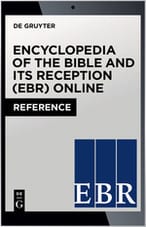The Bible and the Romans: An Interview with Natalie Dohrmann
How does Rome expand the legal empire into the East and how are the Rabbis respond to that? We let Natalie Dohrmann, whose academic background focuses on rabbinic literature and Jews in the Roman Empire, answer this question for you!
This is the third part of an interview series dedicated to the EBR (Encyclopedia of the Bible and Its Reception Online). EBR is a research tool for scholars in biblical studies and related fields
DG: Can you introduce yourself?
Natalie Dohrmann: My name is Natalie Dohrmann. I teach at the University of Pennsylvania and have been working on the EBR for a couple of years now. My field is rabbinic literature and my research is on Jews and the Roman Empire.
De Gruyter: Could you be a bit more specific about your area of research?
ND: In my own research, I’m especially interested in the culture of law—how does Rome expand the legal empire into the East and how are the Rabbis reacting to that, somehow constructing their world out of a Roman one.
DG: What have you discovered?
ND: I have discovered the many ways that the Rabbis were deeply embedded in the Roman world around them. EBR and the way it connects these fields is really useful for me, relevant to how I think about studying Judaism, the way I see ideas traveling and moving through periods, and through corpuses.
DG: So how do you see EBR doing that?
ND: On any given page in EBR you can actually watch the movement of ideas through time and texts, and see how they connect to one another, change—you are actually given a visual of the evolution of biblical ideas through time.
DG: What is actually your role on this project?
ND: My role as one of the area editors has a couple of pieces, each interesting in different ways. The most intellectually rich is the one we do at our annual meeting where we figure out exactly what goes in, what counts as a relevant data point for us to study – and that’s done collectively in conversation with the other editor and it’s fascinating to decide what goes into the volume in the first place.
The next thing is to find the people who can write these pieces and write them well. For me that’s a great way to read more in my discipline, catch up on who’s doing good work, and expand my own intellectual community.
DG: What do you see in the results?
ND: In the pieces that come in? Well, to date, most of my work has been getting people to write. As these essays come in, I will know more, however, what I have read is very solid; the level of EBR is much higher and more precise than I anticipated coming into a project of this scope. The pieces are readable but rigorous, approachable but precise. So, it’s useful for a wide range of levels of expertise.
DG: And your impression of the other editors who work on the project? What is that like and what is your experience with them?
ND: It’s an astoundingly impressive editorial team. I feel honored to be even in the same room with this crowd, it’s really a crackerjack team. I enjoy working with the Judaism group, it has been fun and stimulating, and I’m learning as I’m going for sure. So, working with the EBR team in Berlin is completely easy, and on top of it, they are responsive.
DG: And EBR as a product? What would you say about it?
ND: I think the way I see EBR is, at least in my field, as an extraordinarily useful teaching tool. I teach outside of my expertise all the time, and often need such a reference. For research EBR fills in gaps, and leads to a broader context for any given concept. It allows you to just wander out of your field—you find something you know and then just read above and below and you get a broader picture of what that topic is.
[Title Image by snix2016 on Getty Images ]
